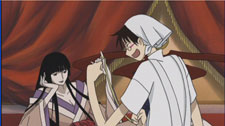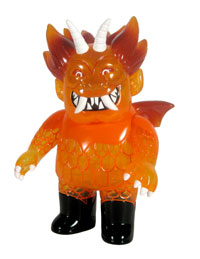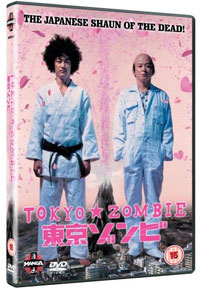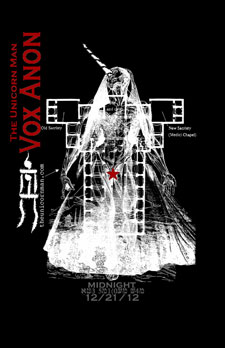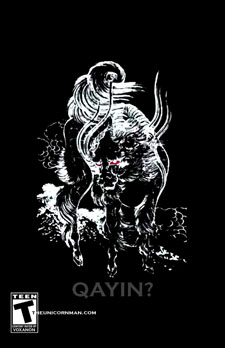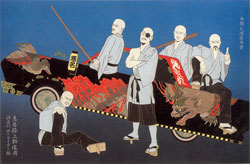 Logo handmade by Bannister
Column by Scott Green
Logo handmade by Bannister
Column by Scott Green
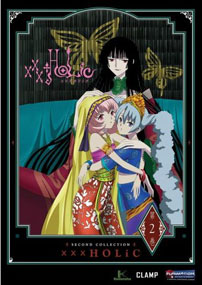
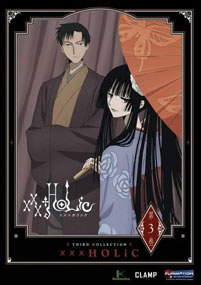
Anime Spotlight: xxxHoLiC Second Collection and Third Collection Released by FUNimation
The Hyakumonogatari Kaidankai (gathering of a hundred ghost stories) is a traditional Japanese social activity in which participants took turns snuffing out a candle after reciting a tale of the supernatural world. The Ouija board-ish part of the process has it that, when the last candle is extinguished, a supernatural presence is drawn to the location of the ceremony. As fictionalized in "Natsuhiko Kyougoku's Hundred Stories," adapted into the anime series Requiem from the Darkness, this prompted an Edo era phenomenon of Grimm-like expeditions of folklore gathering for compilation into printed collections of kaiden. In the following social eras, these ghost stories have consistently returned to the forefront of popular Japanese media, from the frequently adapted Ghost Story of Yotsuya to the Ring and modern "J-horror." The manga creative team CLAMP has attracted a hefty cult following by applying their own stylish spin on popular story precedents, whether old, as in Korean folk tale based Legend of Chun Hyang and Vedic based RG Veda, or as a reaction to modern genres, as in "magical girlfriend" story Chobits or school children in wonderland Magic Knights Rayearth. While CLAMP's work is recognizable through an accentuated version of what could be considered "anime style", where large eyes peek from beneath translucent bangs in cascading sculptures of hair, their work is equally distinctive in the manner in which they play with familiar conventions. The goal you've been conditioned to look for through past genre stories, and the goeal that the heroes expect is seldom the true objective.In the vein of reconstructing story traditions to leave their own mark, xxxHoLiC is CLAMP's Hyakumonogatari Kaidankai. Various known spooky short stories, such as the Monkey's Paw, encounters with spirits and lost girls on deserted roads, even an in-story performance of the gathering of a hundred ghost stories, are all repurposed to reflect modern phobia. Or, more specifically, modern obsessions. The "xxx" of the title is a place holder for a "holic" addiction. The stories are either known or they are predictable. That the subject of a given story neglects her family in favor of servicing an addiction to online communications is not the fresh coat of paint that distinguishes xxxHoLiC. Repeating a pattern that is familiar from other horror anthologies, as well as within the show, at at least one point, it almost seems as if an earlier episode is being repeated. Instead of focusing on the twist or the startling revelation of the story, xxxHoLiC emphasizes the CLAMPed telling. In this case, Kimihiro Watanuki (written out as "April 1st" in Japanese) is promoted from joke rival/comedy supporting character to principal. This anime Don Knots is plagued by the duel trouble of seeing and attracting creatures from the spirit world. Lovecraftian crawling voids chase him. Obsessions manifest themselves as nauseating black flogs. Ghosts, animistic spirits, and other yokai pay him unwanted attention. Though the situation causes him ceaseless aggravation, after a fashion, he finds solace in his "rival," unflappably stoic noble spirit Shizuka Dômeki, and Himawari Kunogi, his crush, who is too sweet to weigh her affection too far towards either Watanuki or Dômeki. Then, there is the instigator/catalyst of the piece, "Dimensional Witch" Yuko. This CLAMP shared-verse megapower operates a bizarre enterprise in which she apparently lounges, drinks, and grants wishes in exchange for something of equal worth. This might be Watanuki's desire to be free of troublesome spirits, for which she accepts his service as a domestic and go-fer, or it might involve the subject of the episode's horror story, for which Watanuki is either sent out as a field agent or he's compelled to observe the wisher meeting their often unfortunate destiny by his intrinsic decency. CLAMP fans are sure to eat this up. Their stories excel at smartly modulating tone. Characters repeat their patterns of behavior, but the dynamic is spirited enough that they are more likable for their predictability. The oscillation between manic comedy and heartfelt emotion as Watanuki spazzes about working with Dômeki, then settles into realizing the significance of what he's seen and done never ceases to draw out the desired reaction. Watanuki might be the eyes and heart of xxxHoLiC, but Yuko is a star attraction. Between her hedonism, style and commanding charisma, it's easy to imagine her as the focus of a cult of personality. Factor in parade of elegantly attention drawing design, and the ingredients of CLAMP's success are all present and accounted for. But, then again, CLAMP fans already know all of this. For fans of"J-horror," yokai and other aspects of Japan's supernatural traditions, look at xxxHOLiC from the lens of the genre conventions that you know and you will find quite an interesting work. Especially in the anime version, with its additional room to contrast character hair colors, the protagonists of xxxHoLiC almost look like the dead, wet, girls of J-horror. Their complexions are pale. Their hair is naturally long, and though idealized, in a manner of unmanageable disarray. Though the embellishments of curving smoke often gives the anime or manga an Art Nouveau look, the elongated "noodle person" figures could equally be applied to the wronged, deceased crawling out of a well. The genre irony to this is a real delight. Strip these characters of their expressions and their personalities and someone like the twisting and scuttling, agitated Watanuki mirrors the ghosts he strives to avoid. CLAMP's manga locked these characters into a narrow confinement with their literal and figurative demons through pitch black space filling the background of panels or fencing cascades of tight, parallel lines. Production I.G's anime takes an alternative track. The world of the anime consists of Watanuki, Dômeki, Himawari, the spirits, and the afflicted. Anyone one on the street or the classroom who is not a player in events is a blank shade rather than a solid person. In other words, in a Revolutionary Girl Utena surreal style, xxxHOLiC is a world of nothing but kaiden. Someone who was blown away by the Tsumani Summoners in Kazuo Umezu's Cat Eyed Boy might not be entirely enamored with the personality, and drama laden CLAMP-ized reflections of rain spirits, house spirits and so on, but the exercise is that much more fascinating for the repurposing. Take or leave the results, the effort is a must see for fans of the genre.
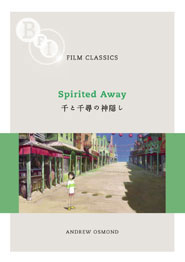
Resource Spotlight: Spirited Away (BFI Films Classics) By Andrew Osmond Released by British Film Institute and Palgrave Macmillan
Issue 90 of North American anime journal Protoculture Addicts included a feature piece entitle "Top 9 Directors (Who Aren't Hayao Miyazaki)." With Miyazaki's absence, the list had some semblance of mystery and distinctive voice. The problem for a list like that is, whether you're considering hardcore anime fans, casual anime fan, animation enthusiasts, cinema-philes or just informed media viewers, Hayao Miyazaki is going to stand out as the preeminent mind in the field of anime. This might be terribly reductive. The response to "the greatest film director" is generally a list, not an individual. Few would name a specific western film director and say that their work validates the potential to produce art through film. Yet, the fact that Miyazaki's name is synonymous with engaging, artful anime is telling. Andrew Osmond's book explores why Miyazaki's seventh feature directorial effort, 2001's Spirited Away specifically commanded so much attention, and why this film, of Miyazaki's body of work, became Japan's most successful film as well as one of the top-grossing "foreign language" films ever released. It's the kind of poetic, insightful examination that the Academy Award winning Spirited Away deserves. Anime has received its share of scholarly text, and it has been surveyed by film critics, but Osmond‘s work represents a rare opportunity to read a thorough study by a writer capable of bringing a wealth of anime and film knowledge to the subject. Osmond interprets why the film has captivated both Japanese and international audiences. He explains the production roots of its convoluted story. And, he addresses the charged concerns that surround the film, including registering his insight as to whether Spirited Away is an allegory for child prostitution. The book offers a chronological analysis of Spirited Away, as well as a look at its inspiration and context. Additionally it recounts Hayao Miyazaki's history as a director, from his work as an animator on films like Hols: Prince of the Sun, to directing television anime like Future Boy Conan, to his creation of the manga version of Nausicaa of the Valley of the Wind, and the founding of Studio Ghibli. Osmond's book relates Miyazaki's time within the medium with little trivia and a wealth of gracefully condensed history. If you are not familiar with the history of anime, or Miyazaki's role in particular, the book is an excellent resource to fill in those gaps, along with a concept of how that historical knowledge is relevant. For example, a lineage is drawn between Spirited Away's protagonist precariously running, almost falling, down an exterior set of stairs, and a similar, then-gag in which Lupin III hops from spire to spire in Castle of Cagliostro. That Castle of Cagliostro scene represents a school of thought in animation that can be associated with the film's animation director, legend in early, modern anime Yasuo Otsuka (Alakazam the Great, Hols, Moomin). Illustrating the part that Spirited Away has to tell in the evolving story of the anime tradition, leap ahead 22 years and that Spirited Away stair scene runs into a sequence tied to Shinya Ohira, an animator who remains at the forefront with works including Kid's Story in Animatrix and Wanwa the Puppy in Genius party. For well read anime fans, much of the books articulated sentiments and history are probably known. Yet, there is value to be gleamed from Osmond's effort to fit the work into a larger framework of animation and film, even if you can spot the references to the work of beloved poet/children author Kenji Miyazawa or know of animation Masashi Ando's influence on the film and the tensions between impulses to present its heroine as an ordinary girl and impulses to place her in the lineage of other Miyazaki heroines, like Kiki or Nausicaa. If the shop talk is familiar, the analysis of topics such as how Miyazaki employs design elements to evokes nostalgia and at the same time alienate native audiences are still eye opening. The resource offers a creative context for Spirited Away, within the evolution of Miyazaki's work, within the history of anime, and beyond that, within the artistic, critical and commercial facets of film. While relating the facts, Osmond points to themes and subtexts to consider when viewing Spirited Away. In particular, Spirited Away's vision of its heroine as an upper-middle class Japanese child of the 90's seems to have relevance for modern America, as made clear when Osmond refers to the "languid" character introduced in the movie's first act as a child who has "grown up in a recession that has caused her no physical hardship, but has, Miyazaki argues, triggered an insidious spiritual decline." Any Miyazaki appreciator would be well served by the books insight into the beloved creator's work. To depart from the text of Osmond's book, but to talk to some thoughts it provoked, I'd ask, "does Miyazaki succeed as an artist?" Miyazaki is notoriously critical of friends, co-workers, family, rivals and so on. He and the Ghost in the Shell anime movie's Mamoru Oshii have been trading barbs for decades. Osmond relates how Miyazaki used a daughter of a friend as a model for the heroine of Spirited Away, and how Miyazaki referred to the 10 year old as a "lazy bum." Along that line, the Miyazaki-legend goes... a friend or an acquaintance complemented Hayao Miyaki, saying "my daughter adores My Neighbor Totoro! She watches the movie every day." To which Miyazaki responded in horror "don't let her do that. Get her a dog. Caring for the animal will teach her real, valuable lessons." Why do Miyazaki movies inspire wonder and adoration and not the values expressed within the movies themselves: virtue through work and responsibility, ecology, social justice? There have by efforts to save "Totoro's Forest,", but does the experience of watching Spirited Away or Kiki's Delivery Service suggest that a parent should consider encouraging their child to take on more chores, or a child to take on more responsibility? Like many innovators/perfectionists, Miyazaki's desire to succeed is a complex force. Chatter suggests that one of the inspirations for Miyazaki's return from an announced retirement to direct Spirited Away was the tepid reaction to Studio Ghibli's 1999 release of the un-Miyazaki like comic strip adaption My Neighbors the Yamadas. And regardless of his socialist inclinations, he seems to like the nice things that success brings. To add more gossip to the pile, much is made of the selection of an Audi A4 to be driven in Spirited Away's opening scene... Miyazaki was said to be driving a blue one himself. As demonstrated in the twists taken by Howl's Moving Castle, the interaction between Miyazaki's values and what he sees happening in the world at large do inspire and steer his movies. To what extent is that tempered by his desire to create an engrossing product? Few miss the irony in Wall*E producing mountains of disposable promotional material and merchandise. Is it equally ironic that children watch Miyazaki movies repeatedly? I'm not saying that his films are not complex beautiful works. I'll probably be eternally fond of them. But, when considering Miyazaki as the inarguable, greatest anime director, maybe it is worth arguing whether his work successfully reflect his intentions.
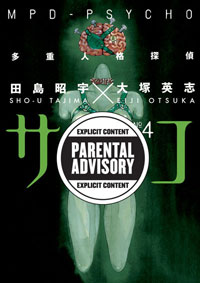
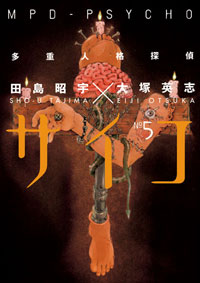
Manga Spotlight: MPD-Psycho Volumes 4 and 5 By Sho-u Tajima and Eiji Otsuka Released by Dark Horse Manga
To use a Mamoru Oshii-ism, MPD-Psycho is a wolf among the dogs of splatter horror. The calling-card of MPD-Psycho is images like the cover of volume 4: a limbless female torso, bound in S&M bondage straps below a floating human brain crowned with Frankenstein bolts. The sex and violence implied by the image are not exactly harmonious neighbors. Nor are the female torso and the brain, the latter of which is embedded with an eye ball and eye patch identifiably belonging to a specific, male character. MPD-Psycho establishes itself by implanting these images into the mind of its reader. One reason why horror is well suited to manga/comics is that the sequential medium can brings its reader to a single, searing image. Film might be forced to continue moving, but manga can come to a complete, dead halt when it slaps the reader with a staggeringly gruesome vision. This might occur quickly in the midst of confusion or conclusively as the narrative hits a pit fall, but when MPD-Psycho starts painting the town red, the results are unforgettable. You'll never have to search your memory to recall specific instances where MPD-Psycho's violence left an impression. However, rather than provoking thrills, these spectacles of people dying painful, humiliating deaths are a cause for tension. Much of MPD-Psycho concerns wolves hunting wolves, or even wolves herding wolves. Most volumes are occupied by a particular scenario in which one deranged killer or a cadre of killers architects a trap, generally baited with innocent victims, but set for other similarly minded killers. Atmospherically, these are more like the one-ups-menship and stare downs of a Leone western than a source of the vicariously fear inspired by predator and prey. The de facto hero of the manga is a police detective whose personality gave way to a split between a coldly effective criminal profiler and a sadistic serial killer. In the absence of a final girl or a charming anti-hero, the manga's protagonist is one of a number of pathological killers, serving as a game piece on a boards whose perimeters is consistently expanding and whose rules are constantly being obfuscated. If this volatile protagonist wasn't enough to alienate your sympathies, there's the trouble that the plague of serial killers that the titular multi-personality disorder afflicted investigator/executioner must contend with are tied into a convoluted conspiracy involving a rock legend turned terrorist and a set of sci-fi conceits that don't entirely fit comfortably with the knifes and guns violence at the forefront of the manga. Dark Knight's magic cell-phone radar has nothing on the mechanisms behind MPD-Psycho's plot. While the manga has gone to the well of using young women victims, the pathos that the manga uncovers is more often than not tied to terrible people in the midst of doing terrible things. Was is the Bible that said "the rain falls on the wicked and the just alike?" In the case of MPD-Psycho, bad things happening to bad people does not serve to humanize or explain these predictors. These people are not Dexter, trying to relate to a reader/audience in their fractured way. Within the context of the manga, they are making statements and taking actions meant to be appreciated by others of their kind. In this scheme the viewer is an observer and not an emotional or intellectual participent. You can appreciate what is being shown, but the manga defies predicting or relating to the characters. That bewildering quality of not knowing where the manga's conspiracy will turn, and not knowing who, if anyone to invest empathy results in an on-guard experience. If horror manga like the works of Junji Ito or Kazuo Umezu could be likened to walking into a dimly lit house, knowing that in some room someone will leap out of a closet, MPD-Psycho is like standing face to face with an elder sibling or relative, knowing that at some point they are going to reach out and slap you across the head, probably with a speed that would prevent you from deflecting the blow... not really scary, but adrenaline drenched, and nerve wracking none the less. MPD-Psycho's ideological stance is equally disorienting. Eiji Otsuka's Kurosagi Corpse Delivery Service has the be the most liberal arts spirited manga published in North America. Otsuka is a social critic, with a background in which he studied subjects that included anthropology, women's folklore, human sacrifice and post-war manga. The presence of a subtext in MPD-Psycho is discernable, but it is almost as much a mystery as the conspiracy within the plot. Broadsides on teenage bullying or geek clinging to adolescent behavior seems too easy to be clues. Is horror defender Otsuka condemning violence in the media as a satire? Was the decision to weave John Lennon assassin Mark David Chapman a cheap move to interweave the plot of MPD-Psycho with real killer-lore or an effort to solidify its link to the black areas in the history of popular music? Otsuka deserves credit for producing something smarter than simple gross out serial killer porn. MPD-Psycho is intriguing and it is thought provoking. Never the less, some of those thoughts are "is there something here that I'm not getting?" and "what's the net of this whole thing?"
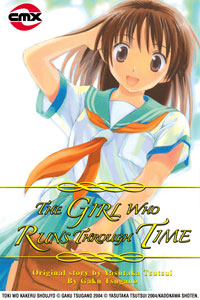
Manga Spotlight: The Girl Who Runs Through Time By Gaku Tsugano, based on story by Yasutaka Tsutsui To be released by CMX September 24, 2008
After previously appearing in isolated North American screenings during conferences, conventions and festivals, the 2006 anime feature "The Girl Who Leapt Through Time" has begun appearing in short theatrical engagements in select cities (next being August 29-September 4 in Seattle), with a DVD release forthcoming. The Mamoru Hosoda directed feature offers the kind of beautiful, resonate human film that an animation fan would expect of a Hayao Miyazaki work, but in a style particular to its director. Hosoda constructed a charged, emotional experience through the not entirely unfamiliar story of a girl who stumbles on the ability to go back in time. Tinkering with previous events relative to one's own life is not exactly a new conceit in fiction. For Japanese audiences, that familiarity is even more pronounced. Influential, controversial, beloved and inflammatory writer Yasutaka Tsutsui penned the original Toki o Kakeru Shojo novel in 1976. (Anime fans should note that Tsutsui also wrote the story on which Satoshi Kon's Paprika is based; English translated Tsutsui prose include short story collection Salmonella Men on Planet Porno and novel Hell). Since then, Toki o Kakeru Shojo or the Girl Who Leapt/Ran/Runs Through Time has inspired live action films in 1983, 1997 and 2002 (the last of which was made for TV as a vehicle for idol group Morning Musume), a 1994 TV drama series, two works of manga, and Hosoda's animated film. Gaku Tsugano's 2004 manga adaptation of the novel predates the 2006 anime. It's not the same story, or even the same character, though there is an implied connection in the 2006 version. However, a caveat is still warranted. Hosoda's film provokes impassioned reactions. There is an abrupt revelation that almost seems to intentionally derail the movie. Even if Hosoda picks a moment for the reveal where the audience's attention is directed elsewhere, almost deliberately ensuring that it is a jarring moment, considering how well known the previous works were in Japan, the revealed reaction is probably more acute for North Americans approaching the anime as their first exposure to the story. The Girl Who Runs Through Time is not going to spoil the Girl Who Leapt Through Time. But, having read the former will affect the experience of seeing the latter. Runs is a competent short manga (two volumes), and Leapt is an enthralling masterpiece. In other words, maybe it is better to read the former after the seeing the latter. Though The Girl Who Runs Through Time's relationship subject matter and its mode of telling a story through expressive facial illustrations and context shots resemble those of shoujo (manga for young, female audiences), the series is in fact seinen (manga for males from their older teen years, into adulthood). The genre of manga is dictated by the Japanese anthology in which the manga ran. In this case, the manga ran in the same Ace Tokuno anthology about the same time as some of Ghost in the Shell director Mamoru Oshii's Kerberos: Panzer Cops manga. In seinen manga, nostalgia is apparently manifested in the form of a high school girl. The prime example of that is Azumanga Daioh, a gentle four panel comic strip looking at the lives of a clique of girls passing through their high school years. Like Azumanga Daioh, in The Girl Who Runs Through Time, memories of friends and small moments of high school are underscored by the fact that the period of life ends after a prescribed span of years. As hazy and confusing as it might be, after a few years, you graduate and it's over. As The Girl Who Runs Through Time opens, Kazuko Yoshiyama's thoughts are drifting between scent-provoked memories and sidling up to her childhood friend as he sits next to her on a bus. Arriving at school, she's volleyed between the principal advising her senior class to remember that their future is imminent and her stern friend's lecture to find a serious boyfriend and a defined direction. In all derivations of the story, the origin of the girl who moves through time occurs during an afterschool assignment to clean a science lab room. After a concussive accident, the subject tumbles into the ability to move through time. In Runs and in Leapt, the girl uses the ability to protect those in-between moments that make for small, pleasant memories, such as a favorite snack or meal. Kazuko also uses the ability to protect and improve more substantial past and potential memories, such as the final day with her beloved grandmother or her friend's ability to compete in the athletic competition that he had been working towards. While these trips in time are initially beneficial, the law of unintended consequences is quick to catch up. Tsugano utilizes the tools of the medium by employing a compound visual metaphor. As the manga develops, it cuts to images of a butterfly emerging from its chrysalis. Dialog explicitly invokes the concept of a "butterfly effect," where the wing beats of a butterfly could cause an air disturbance that would result in a storm on the other side of the world. In this case, the consequences of an small action are magnified by the passage of time. Simultaneously, the butterfly serves to signify maturation, and the changes undergone when reaching adulthood. As obvious and unsubtle as this might be, Tsugano does utilize it to construct provocative points concerning the appeal and danger of nostalgia. As endeavoring as Kazuko's childlike qualities and sentimentality might be, her inclination to dwell in the past has its consequences. If The Girl Who Runs Through Time was content to stay small, it could have been a powerfully moving manga. Unfortunately, as an adaptation, it is stuck chasing something larger. Even read as a stand-alone, without plans to see the anime, live action or novel, it is evident that the manga is working through a prescribed agenda. Within the run time of the movie (a fairly long for anime 98 minutes), Hosoda was able to demonstrate a progression in which tumbling pebbles gathered the momentum to trigger a rock slide. Rather than utilize events that fit the scale of a two volume work, the manga is forced to rattle with sudden tectonic shifts. Suddenly, action A causes critical result B. Tsugano does not rest on the knowledge that he is adapting a well regarded, maybe beloved story. He captures some of Tsutsui's pairing of a potentially intriguing sci-fi conceit with a subversive message. In the mode of a seinen manga, Tsugano effectively presents a hapless, cute female lead (reminiscent of School Rumble), juxtaposed with more serious peers. In its symbolism and character design, the manga platform is well utilized. But, ultimately, The Girl Who Runs Through Time does not escape being a two volume adaptation. As such, what it desires to tell is an imperfect fit for the form and space in which it is told.
Upcoming in Japan
Anime Nation reports Yasuomi Umetsu's blog has revealed that he will be writing a sequel to his Kite Liberator OVATetsudou Musume ("Railway Girl"), the manga based on a line of figures featuring young women dressed will be adapted into a live action series. Street racing anime/manga Initial D will continue in Initial D Extra Stage 2: Tabidachi no Green, scheduled to be released on DVD December 5th. Via Anime News Network Harold Sakuishi's 77 page side story to his rock manga Beck in the October issue (on sale on September 6) of Kodansha's Monthly Shonen Magazine. "The Last Day of Eddie Lee" captures a new facet of the 34 volume manga series. Shin Jigoku Shoujo (New Hell Girl) commences in the new issue of Kodansha's Nakayoshi. Miyuki Etoo will return to draw the manga. The new Hell Girl anime, Jigoku Shoujo Mitsuganae, will premiere on October 4. Jump Square will be collaborating with makers of the musical adaptation of The Prince of Tennis on a "miraculous" future project. Kozue Amano, creator of the pastoral sci-fi manga Aria, will launch a currently untitled manga series in Mag Garden's Comic Blade. Japanator collects rumors concerning the Gurren Lagann movie Ryuganji reports "nobody and Horipro talent Kinami Haruka" has been cast as Koizumi Kyoko in the second part of the live action adaptation of Naoki Urasawa's 20th Century Boys. The character is a teenage would-be groupie who stumbles into the sight of the "Friend" cult. Previews/trailers Battle Spirits Vampire Knight Guilty Studio 4C's First Squad
AICN Figures News...
Sideshow Collectables is taking pre-orders for the Organic PVC figure of Witchblade's Reina Soho. The figure will be released in 4th Qtr 2008 for $54.99Super7 announced a collaboration with Martin Ontiveros and Gargamel on the Super7 x Martin Ontiveros x Gargamel Burning Ojo Rojo. The Burning Ojo Rojo is 6 inches tall and will be offered for sale at $100, Tuesday, September 9th at 11am Pacific at the Super7 Store and distribution partners. * Good Smile, now in English Gag/horror luminary Kazuo Umezu based figures! Super Punch looks at PLUS Vinyl Figures from Devilrobots + TokidokiHow Girl Figures looks the Griffon's figure of Eureka 7's Talhi Also, Gurren Lagann's bounty hunter Yoko Danny Choo collect from Gundam figures from Chara Hobby Also Lucky Star's Tsukasa Hiiragi Vacation Edition Revoltech Yotsuba Speaking of Yotsuba, waiting for volume 6 of the English localzation of Yotsuba? Japan recently got their hands on the eighth collection * Noteworthy CollectionDX coverage Moyashimon or Tales of Agriculture is an award winning anime/manga looking a bacteria Fraulein Revoltech represents a figure dedicate to fermentation Revoltech Gurren Lagann Fulldrillized Deluxe-class Decepticon Soundwave Deluxe-class Autobot Jazz Kaiju Big Battel's Vegetius For the Voltron fans Robeast Mutilor* An the custom from, a staggering Jill Valentine Tranformer Custom Damaged Cobra Battle Android Trooper by "TheTransTorture"
Event News
Bandai Entertainment Inc. and Kadokawa Pictures USA announced that Landmark Theatres Varsity Theater has extended the run of the theatrical release of The Girl Who Leapt Through into a 2nd Week. The Landmark Theatres Varsity in Seattle currently plans to extend the film through September 11th Showtimes for September 5-11th are: Fri-Sun at 2:40, 4:50, 7:10, 9:20 and Mon-Thur at 7:10, 9:20. The New York Anime Festival today it has partnered with VIZ Pictures to hold Death Note Day at New York City's Kinokuniya Bookstore -- on Sunday, September 14. Kinokuniya Bookstore, located at 1073 Avenue of the Americas in Manhattan, will present a day-long series of events celebrating the US DVD release of the Death Note motion picture by VIZ Pictures. The Death Note movie goes on sale at retailers across America on Tuesday, September 16, but Kinokuniya will have the movie in stock on Sunday, September 14. In addition, the first 50 fans to purchase the Death Note movie on DVD on September 14 will receive a limited-edition Death Note theatrical poster from VIZ Pictures. New York Anime Festival's panel schedule Providence anime conferences panel descriptions The Anime Expo organizers at the Society for the Promotion of Japanese Animation announced that Steve M. Rezayat is joining the organization as Chief Financial Officer. Rezayat is a seasoned financial management executive with over 36 years of experience and holds a Master's degree in Management and a Bachelor's degree in Accounting. New York - Tokyo has announced winners of the New York - Tokyo Film Grand Prix 2008 Films selected to be shown at NYTFGP Festival include 77Boadrum Asyl: Park and Love Hotel Bloody Snake under the Sun Corazon de Melon Death of Domomata Grave of Fireflies GS Wonderland Kamachop Nightmare Detective 2 Yah-Chaika
Tokyo Zombie Live Action English Bound
AICN Anime is very fond of Yusuku Hanakuma's Tokyo Zombie manga. The live action adaptation will be released by Manga Entertainment in the UK October 13 And the US by Video Treasures on November 11, 2008 Thanks for "logboy" for the heads-up.
Unicorn Man
For those looking for something interesting, not necessarily in the anime/manga territory, Unicorn Man, "a collection of poems & images dealing with Beauty, Love, G-d, & Death," looks like it fits the bill. The work includes 3 short stories with 216 poems/diary entries and 55 black and white digital collages. Cain or Qayin committed the first murder over LOVE & beauty. Some believe he is the king of all undead, the father of all vampire lineages till now. A strange man awakes during brain surgery to find he has no memory of who or what he is. A rare pineal gland disease has transformed this man into the world's most dangerous beast - The Unicorn Man who while suffering amnesia vows to find out his true identity. Until he can find a cure for his disease he searches New York City, hiding from those who would kill him for the treasured contents of his forehead. Across the millennia he has existed in a dream. Alone he has wandered the four corners of the earth in pursuit of death itself. It is December 20, 2012 12 minutes to midnight his search leads him to the top of Freedom Tower in New York City where he must choose between saving the world, himself, or a girl...Vox Anon presents The Unicorn Man.
Worth Checking Out...
Excellent Gundam news blog Gunota signs out* Media: Via Ninja Consultants, anime podcast luminaries record their Otakon Gathering Anime Jump's Mike Toole return to ANNtv to presents Dubs That Time Forgot Episode 74 of Right Stuf's Anime Today podcast features YEN PLUS monthly anthology – Co-Publishing Director Kurt Hassler and Senior Editor JuYoun Lee. In this new interview, Hassler and Lee discuss YEN PLUS’ launch, the role they feel anthologies can play in the North American manga and graphic novel market, the selection process to determine which titles appeared in the debut issue, and what fans can expect to see in future issues. A Same Hat! look at Kazuo Umezu YouTube Channel A look at Jesus and Buddha in Nakamura Hikaru's Saint?Young Men CLAMP and Take Shobo team up for mahjong manga Matt Thorn resurrects Margaret manga with more here P. Craig Russell's illustrations from the comic adaptation of Sandman: Dream Hunters, the original of which was illustrated by Yoshitaka Amano Robotech is now available through iTunes* Interviews: Eye on Anime spoke to Helen McCarthy about the Osamu Tezuka retrospective Publishers Weekly talks to translator Ryan Sands (Same Hat! Same Hat!) about Tokyo Zombie Sci-Fi Japan spoke to Hiroko Yoda and Matt Alt about Yokai Attack Alan Burnett and Greg Rucka on Batman: Gotham Knight* Games Super Robot Wars Z media A preview of Dynasty Warriors: Gundam 2, also here Dragon Ball Origins for the Nintendo DS >Naruto: Ultimate Ninja Storm for the PS3Naruto: The Broken Bond for the Xbox 360 Anime style Red Versus Blue Apropos of little, but definitely cool The King of Fighters '98 Ultimate Match will be on XBLA* Previews A preview of the Gurren Lagann focused Protoculture Addicts #97 Otaku USA tips their hat on what's to come from the magazine. Popculture Shick posted a preview of the the Afro Samurai manga, as well as a look at how work evolved* Insight AniPages Daily works up to episode 9 in the blog's Kaiba analysis Otaku USA's online coverage include surveys of The Slayers and Metal Gear Solid, as well as features on Gunbuster vs Diebuster, Turn A Gundam and Gateway anime Efforts against unauthorized translations are stepped up Via AstroBoy World, UK's Telegraph looks at the animators of the CGI AstroBoy and Gatchaman, Imagi UK's Guardian gives is too enthusiastic about Ponyo MangaBlog compares Takehiko Inoue's highschool ball Slam Dunk and wheel chair basketball series Real. Mecha Mecha Media looks back at the summer here and here The site and a geek by any other name looked at Dark Horse's Kumoricon comments. Iwa ni Hana on The meaning of 'youen' and Mononoke A look into the Japanese anime industry* Misc Intermixi and Tokyogetter.com have launched a "Show Us Your Dubs" contest for old school, VHS era fansA list of September anime releases and conventions An Eternal Thought in the Mind of Godzilla presents Tatsuji Kajita's Godzilla: Asahi Sonorama Sono Sheet cover art Ultraman re-purposed Via Awesome Engine Haruhi Suzumiya vs Jojo's Bizarre Adventure mash-up
For more commentary see the AICN Anime MySpace.




